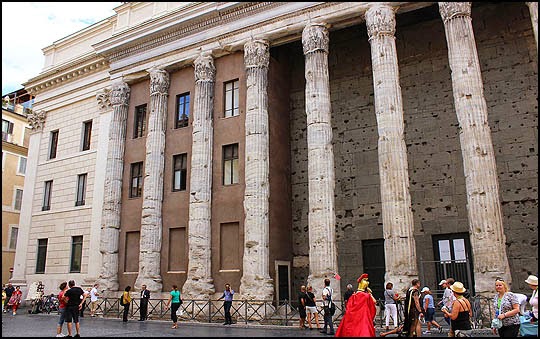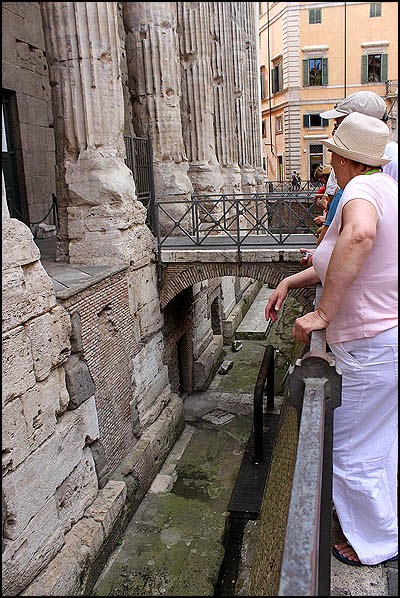Tuesday 2 September 2014. I've already described the first part of our day in Rome which was spent in the Vatican. We left St Peter's Square in a long straggly crocodile.

Castle Sant'Angelo. Built by Emperor Hadrian as his mausoleum it was built 130-139 AD. It was converted to a fortress in 401 and as the Goths sacked Rome most of the statues upon its walls were thrown down onto the attackers in 537. However the cap stone of a funerary urn, thought to be Hadrian's, was found and now covers the baptismal font in St Peter's Basilica.
There is a legend that the Archangel Michael appeared on top of the fortress in 590, sheathing his sword as an outbreak of plague came to an end. This is commemorated by his statue on the roof. Another version is that during the plague, Pope Gregory I heard that the population had turned to worshipping a pagan statue. The Pope led a procession to the statue which fell apart with a clap of thunder at his approach. The angel then appeared wiping blood from his sword before sheathing it.
The popes converted the fortress to a residence from the 14th century but it was also used as a prison. Giordano Bruno, the defrocked monk who previously fled to England, ending up working for Queen Elizabeth's spy-master, Walsingham, was imprisoned here for six years. It is linked by a covered passageway via the Vatican Wall to St Peter's Basilica, the hero's flight along this being a memorable episode in Dan Brown's book, Angels and Demons. And before we move on totally, let's have a closer look at a portion of this photo...

A brilliant bit of hokum! One man holds a stick in one outstretched hand only, bearing all the weight of another man perched on top of it. Very effective, but...
The strongman is sitting on a metal plate and from it a welded iron pole up goes under his robes up his side and under his arm so he can rest his arm on it. Holding the next right-angle hides it and makes it look like a single stick. The other guy is sitting on a second plate, probably shaped so he doesn't move off the balance point. Others on the tour were oohing and aahing but I'm just a touch cynical... ha ha!

St Angelo Bridge over the River Tiber, the famous river of Rome, 252 miles long. Rome was built along it's eastern bank. It's been cleaned up a bit since the ancient Romans used to throw the bodies of executed criminals into it. Not only ancient Roman criminals... In January 897 Pope Steven VI had the last but one pope, Formosus, exhumed and regardless of his death put the rotting corpse on a throne and on trial for performing the rites of pope whilst deposed. The corpse was found guilty, had the three fingers used for performing a blessing removed and was reburied. Presumably nettled because the corpse had shown no remorse at all, the Pope had it dug up again and thrown in the Tiber. The St Angelo bridge is one of a very few ancient surviving bridges, though not all of the bridge is all that old.

Horti Palantini, the entrance to the Farnesi Gardens, the first private horticultural gardens in Rome. They were created by Cardinal Farnesi, brother to Julia, the mistress of Pope Alexander VI - the Borgia pope.

The Arch of Constantine, raised by the Senate to commemorate the victory of one Roman Emperor, Constantine I over another, Maxentius, at the Battle of Milvian Bridge on October 28, 312 A.D. Maxentius was killed in the battle and... thrown in the River Tiber...

The Coliseum (or Colosseum), built 70-80 AD and the largest Roman amphitheatre in the world. It could hold between 50,000 and 80,000 people and was the site of games, gladiatorial combat, executions and re-enactments of Roman battles (complete with actual slaughter...).
It is one of the most instantly recognised of any building on the planet and receives millions of visitors every year. All around you can hear guides in all languages saying "Hold onto your handbag! Watch your cameras!" It's worth a couple more photos...

Taken pretty much from the same spot as the last photo of the Coliseum, this shot looks up the Via Sacra with the Palatine Hill on the left and the Arch of Titus in the distance. The arch is much older than the previously shown Arch of Constantine, dating from around 82 A.D. and commemorating Titus' victories which included a siege of Jerusalem in 70 A.D. With only a single arch, it has been the inspiration for many subsequent arches including the 19th century Arc de Triomph in Paris. The Palatine Hill is the central hill of the seven hills of Rome and there is evidence of occupation from as far back as 1000 B.C. Its name is accepted to be the origin of many languages' term for palace, palazzo, palais etc. The Roman Forum is below it on one side, Circus Maximus on another.

We got back onto the coach at this point and were dropped off again around the corner from the Trevi Fountain. This wasn't the best time to visit... Any visit to an ancient city or any capital city is bound to include at least one site obscured by scaffolding and the Trevi Fountain was ours in Rome. But hey! It will be sparkling the next time we visit!

We trooped to a nearby restaurant for a meal. We don't tend to eat huge lunches so we ordered a pizza each and had to laugh when we saw it. Should have just ordered the one then... and shared with another couple... It was excellent but we declined a dessert (would have needed a mortgage in fact for a dessert...) and set off for a mooch around as we had about 45 minutes free time.

I can't resist Italian ice cream, but somehow the name of the street was putting me off and we walked around the block first, before buying a couple of absolutely huge lemon-flavoured ices at another of the small Bibite vans. At this point, around ten minutes before meeting with the rest of the tour, a chap from our coach came up and asked us where the Spanish Steps were. We had to tell him that he wouldn't have time to walk there and back.

We now started a walking tour through a maze of narrow streets and larger piazzas at a pace that didn't allow any following on the map. There were lots of tours all doing the same thing so just making sure we kept within sight of our own guide was hard work enough. We could hear him on our ear pieces, but that doesn't help you follow without keeping them in view!
This ancient Roman "something" had been tastefully joined by more modern buildings. Bad taste obviously... The Roman soldier was kept busy pointing his sword at grinning kids and having his photo taken. He must have totally lost contact with his own guide...

Whatever this building was, it had a railed area at the front with a view down a couple of metres to what was the pavement or ground level in ancient Roman times. A bit of dust has settled and hardened since then.

We came to a halt outside this building. This is the Pantheon, built by Marcus Agrippa during the reign of Augustus, adopted son of the first Emperor, Julius Caesar (27 BC - 14 AD). Or not. It is now thought that only the facade - perhaps only the inscription - is in its original form. The temple itself was destroyed by fire at least twice and the current building is thought to date from Trajan, around 114 A.D.
We know from Pliny's writings that Agrippa's version had columns in the form of Caryatides, the female forms seen still holding up the Porch of the Maidens, on the Erechtheum on Athens' Acropolis. Also we know that one of Cleopatra's pearls was cut in half to be used as earrings for the statue of Venus.

The interior of the Pantheon. The dome is shaped as a perfect hemisphere and at such a height that a perfect sphere could stand on the floor at its centre. It had been converted to a Christian church in the early 7th century which has probably been the main factor in its preservation. Whilst the interior has remained remarkably intact the exterior has undergone a bit of asset stripping and shape changing over the centuries. At one point it had twin bell towers over the portico. Derisively known as "the ass's ears", they were removed in the late 1800s.

The dome is of concrete and an incredible feat for its time. The stone used for the higher sections is volcanic pumice and small pieces of pot to keep it light enough to stay up and the thickness of the dome wall gets thinner as it gets higher. The structure of spars and square segments also adds strength and reduces weight. At the apex is an oculus, a hole open to the air to allow light to enter. The opening also saves a bit of weight. This does allow rain to cascade down into the building of course and the floor is shaped so as to allow water to drain away.

The sarcophagus of the artist Raphael (1483-1520) containing, according to the inscription, his "bones and ashes". Rather touchingly, the body of Maria Bibbiena, his fiancée who died before he could marry her, is buried just at the side of his resting place.

The walking tour continues, taking us to the Piazza Navonne where we are given 30 minutes free time. We treat ourselves to some fruit (oh ok, ok, there was ice cream involved...) and a latte machiatto. "Latte" means "milk" so if you ask for a "latte" in Italy you either get asked "solo latte?" ("only milk?") in a wary tone - or you get a glass of milk...
Following this free time we met up with the coach for our trip back to the Thomson Majesty at the port of Civitavecchia.


No comments:
Post a Comment
All comments must be passed by moderator before appearing on this post.